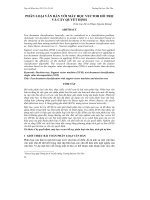Bài giảng Phân tích hệ thống kỹ thuật và quyết định
Bạn đang xem bản rút gọn của tài liệu. Xem và tải ngay bản đầy đủ của tài liệu tại đây (20.89 MB, 234 trang )
ENGINEERING
SYSTEMS &
DECISION
ANALYSIS
(CIVE3066)
COURSE
INTRODUCTION
Instructor:
Nguyen-Tuan-Thanh LE ()
Based on the CIVE203 - Engineering system and decision analysis - Colorado state University, USA
& Role of statistics in engineering – California State University, USA
COURSE OBJECTIVES
▪ Prepare you to effectively use models and statistics in your courses and career
using MatLab/Octave and GIS skills
▪ Provide you with the capabilities of:
▪ Understanding the concepts of mathematical modeling and statistical data analysis as
▪
▪
▪
▪
applied to civil engineering systems.
Estimating parameters for various statistical distributions, determining which distribution
best describes a set of data and to generate random samples from those distributions.
Demonstrating the proper application of confidence limits and hypothesis testing to
examples from civil engineering systems.
Demonstrating the proper application of simple linear or multiple regression for building
empirical models of engineering and scientific data.
Demonstrating the use of Geographic Information Systems (GIS) for spatial data
collection, organization, and analysis.
2
COURSE INSTRUCTORS
▪ Dr. LE Nguyen Tuan Thanh
▪ Email:
▪ Msc. LAI Tuan Anh
▪ Email:
3
EXAMS AND GRADING
▪ The course will include two multiple choice quarterly, a midterm and
a comprehensive final examination.
▪ Grading will be based on the following components:
Attendance
5%
Laboratory exercises
20%
Homework (other than lab)
15%
Multiple Choice Examinations (2)
20%
Midterm Examination
15%
Final Examination
25%
4
HOMEWORKS
▪ Assigned weekly on the piazza forum
▪ Students submit homeworks on piazza with a .zip files including all
necessary files. The name of the .zip file as well as the title of the
email should be: CIVE3066_59NKN_HWK n_Student’s name
▪ where n is the number of the current homework
▪ for example: CIVE3066_59NKN_HWK1_NguyenVanA
▪ Late homework is not accepted
▪ Solutions are posted on piazza or presented in class after due date
▪ Must be your own work. Copied work will have the note 0
5
GENERAL CLASS POLICIES
Students are expected to:
▪ Attend regularly
▪ Ask questions
▪ If you do not understand what the lecturer is saying or if you detect any errors
▪ Access the course forum piazza regularly
▪ Respect the lecture time
▪ Turn off or silence your cell phones before the start of class
▪ Respect assignment deadlines: late submissions will not be accepted.
▪ Be honest:
▪ Violations of the academic integrity policies may include: cheating, plagiarism, aiding
academic dishonesty, fabrication, lying, bribery, and threatening behavior.
6
COURSE CONTENT
EXTENDS: NUMERICAL MODELING & RISK
ANALYSIS
(CIVE3045)
1. Introduction
2. Exploratory data analysis
3. Fundamental of probability
4. Random variables
5. Fitting distributions
6. Hypothesis testing
7. Decision making for a single sample
8. Building empirical models
9. Simple linear regression
7
RECOMMENDED TEXTBOOKS
▪ Engineering Statistics-Fifth Edition, Montgomery, D.C., G.C. Runger and N.F.
Hubele, John Wiley & Sons, Inc., 2011.
▪ Probability Concepts in Engineering- Second Edition, Ang, A. and W. Tang,
John Wiley & Sons, Inc.
▪ Geographic Information Systems and Science, Longley, P., John Wiley & Sons,
Inc.
▪ Applied Numerical Methods with MATLAB for Engineers and Scientists,
Chapra, S.C., McGraw Hill.
8
OTHER MATERIALS
▪ MATLAB Statistics Toolbox, MathWorks Inc.
▪ MATLAB Curve Fitting Toolbox, MathWorks Inc.
▪ Numerical Computing with MATLAB, Moler, C.
▪ Think Stats: Exploratory Data Analysis in Python, Allen B. Downey, 2014.
9
EXPLORATORY
DATA
ANALYSIS
Engineering Systems and
Decision Analysis (CIVE3066)
Instructors:
Nguyen-Tuan-Thanh LE ()
Based on the CIVE203 - Engineering system and decision analysis - Colorado state University, USA
CONTENTS
1. Data sampling
2. Descriptive statistics
3. Data processing
4. Plotting data
Based on the CIVE203 - Engineering system and decision analysis - Colorado state University, USA
2
THE SCIENTIFIC METHOD
Define the problem
Gather information
Construct hypothesis
Collect data and
propose a model
Hypothesis
is false
Analyze results / test
the hypotheses
Draw conclusions
Based on the CIVE203 - Engineering system and decision analysis - Colorado state University, USA
Decisions / Recommendations
3
1. DATA SAMPLING (1/2)
▪Population vs Sample
▪ Example:
▪ You ask randomly 100 chosen people, at a football match, about
which team they like
▪ Your sample is the 100 chosen people, while the population is all
the people at that match
▪ Sample: a selection taken from a larger/total group (the
“Population”) so that you can examine it to find out something
about the larger/total group [1]
Based on the CIVE203 - Engineering system and decision analysis - Colorado state University, USA
[1] />
4
DATA SAMPLING (2/2)
▪Data sampling is a statistical analysis technique
▪ used
to select, manipulate and analyze a
representative subset of data points
▪ in order to identify patterns and trends in the larger
data set being examined [2]
▪How can we get a sample from the population?
▪ Sample design: which strategy?
Based on the CIVE203 - Engineering system and decision analysis - Colorado state University, USA
[2] />
5
DATA COLLECTION:
SAMPLE DESIGN – STRATEGY
▪ Non-probability Sampling: selecting samples based on the subjective
judgment of researchers rather than random selection
▪ Haphazard Sampling (Convenience Sampling)
▪ Judgment Sampling (Purposive/Expert Sampling)
▪ Probability Sampling: sample are chosen using a method based on the
theory of probability
▪ Simple Random Sampling
▪ Stratified Random Sampling
▪ Clustering Sampling
▪ Multistage Sampling
▪ Systematic Sampling
6
NON-PROBABILITY SAMPLING:
HAPHAZARD/CONVENIENCE
SAMPLING
▪ Try to create a random sample by haphazardly choosing items in order to try
and recreate true randomness.
▪ Example: you stand on a busy corner during rush hour and interviewing
people who pass by.
▪ Based on the philosophy of any sampling location will work
▪ Taking samples at convenient locations or times.
▪ A very homogeneous population over time and space is essential to obtain
unbiased estimates
▪ It is very difficult to verify this assumption
Based on the CIVE203 - Engineering system and decision analysis - Colorado state University, USA
7
NON-PROBABILITY SAMPLING:
JUDGMENT/PURPOSIVE/EXPERT SAMPLING
▪ Based on subjective selection of population units by an individual/expert
▪ Samples are selected based purely on researcher’s knowledge and
credibility.
▪ In other words, researchers choose only those who he feels are a right fit
(with respect to attributes and representation of a population) to
participate in research study.
▪ The target population should be clearly defined, homogeneous, and
completely accessible so that sample selection bias is not a problem.
▪ The degree of accuracy is hard to quantify
8
PROBABILITY SAMPLING:
SIMPLE RANDOM SAMPLING (1/3)
▪ Each of the population units has an equal chance of being
selected for measurement.
▪ The selection of one unit does not influence the selection of
other units.
▪ Note that random sampling is not equivalent to selecting
locations haphazardly.
▪ Appropriate
for estimating means and totals when
population does not contain major trends, cycles, or
patterns.
9
PROBABILITY SAMPLING:
SIMPLE RANDOM SAMPLING (2/3) STEPS
1.
A list of all the members of the population is prepared
initially and then each member is marked with a specific
number (for example, there are N members then they will be
numbered from 1 to N)
2.
From this population, random samples are chosen using two
ways:
▪ Method of lottery
▪ Use of random numbers (random number tables, random number
generator software)
▪ A random number generator software is preferred more as the sample
numbers can be generated randomly without human interference.
10
Based on the CIVE203 - Engineering system and decision analysis - Colorado state University, USA
11
Method of lottery
12
Excel Functions:
• RANDBETWEEN(a,b)
• RAND()
13
PROBABILITY SAMPLING:
SIMPLE RANDOM SAMPLING (3/3) – EXAMPLE
▪ An organization has 500 employees. We want to extract a sample of
100 from them.
▪ Step 1: Make a list of all the employees working in the organization
▪ As mentioned above there are 500 employees in the organization, the list must contain
500 names).
▪ Step 2: Assign a sequential number to each employee (1,2,3…500). This is
your sampling frame (the list from which you draw your simple random sample).
▪ Step 3: Figure out what your sample size is going to be.
▪ In this case, the sample size is 100
▪ Step 4: Use a random number generator to select the sample, using your
sampling frame (population size) from Step 2 and your sample size from Step 3.
▪ In this case, your sample size is 100 and your population is 500, so generate 100
random numbers between 1 and 500.
14
PROBABILITY SAMPLING:
STRATIFIED RANDOM SAMPLING (1/2)
▪ The
target population is divided into non-overlapping,
homogeneous sub-regions/groups called strata (statum) to obtain
a better estimation of the mean of the population.
▪ Age, socioeconomic divisions, nationality, religion, educational
achievements, … fall under stratified random sampling.
▪ Samples within each strata is selected by Simple Random
Sampling.
▪ Useful when a heterogeneous population can be broken down
into parts that are internally homogeneous.
Based on the CIVE203 - Engineering system and decision analysis - Colorado state University, USA
15
Based on the CIVE203 - Engineering system and decision analysis - Colorado state University, USA
16








